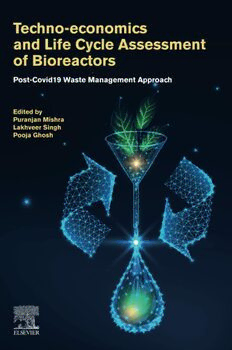
Techno-economics and Life Cycle Assessment of Bioreactors: Post-COVID-19 Waste Management Approach PDF
Preview Techno-economics and Life Cycle Assessment of Bioreactors: Post-COVID-19 Waste Management Approach
Techno-economics and Life Cycle Assessment of Bioreactors This pageintentionallyleftblank Techno-economics and Life Cycle Assessment of Bioreactors Post-Covid19 Waste Management Approach Editedby PURANJAN MISHRA Faculty of Civil Engineering Technology, Universiti Malaysia Pahang (UMP), Gambang, Pahang, Malaysia LAKHVEER SINGH Department of Environment Science,SRM-University-AP, Amaravati, India POOJA GHOSH CentreforRural Development and Technology, Indian Institute of Technology Delhi, New Delhi,India Elsevier Radarweg29,POBox211,1000AEAmsterdam,Netherlands TheBoulevard,LangfordLane,Kidlington,OxfordOX51GB,UnitedKingdom 50HampshireStreet,5thFloor,Cambridge,MA02139,UnitedStates Copyright©2022ElsevierInc.Allrightsreserved. Nopartofthispublicationmaybereproducedortransmittedinanyformorbyanymeans, electronicormechanical,includingphotocopying,recording,oranyinformationstorageand retrievalsystem,withoutpermissioninwritingfromthepublisher.Detailsonhowtoseek permission,furtherinformationaboutthePublisher’spermissionspoliciesandour arrangementswithorganizationssuchastheCopyrightClearanceCenterandtheCopyright LicensingAgency,canbefoundatourwebsite:www.elsevier.com/permissions. Thisbookandtheindividualcontributionscontainedinitareprotectedundercopyrightby thePublisher(otherthanasmaybenotedherein). Notices Knowledgeandbestpracticeinthisfieldareconstantlychanging.Asnewresearchand experiencebroadenourunderstanding,changesinresearchmethods,professionalpractices, ormedicaltreatmentmaybecomenecessary. Practitionersandresearchersmustalwaysrelyontheirownexperienceandknowledgein evaluatingandusinganyinformation,methods,compounds,orexperimentsdescribed herein.Inusingsuchinformationormethodstheyshouldbemindfuloftheirownsafety andthesafetyofothers,includingpartiesforwhomtheyhaveaprofessionalresponsibility. Tothefullestextentofthelaw,neitherthePublishernortheauthors,contributors,or editors,assumeanyliabilityforanyinjuryand/ordamagetopersonsorpropertyasamatter ofproductsliability,negligenceorotherwise,orfromanyuseoroperationofanymethods, products,instructions,orideascontainedinthematerialherein. ISBN:978-0-323-89848-5 ForInformationonallElsevierpublications visitourwebsiteathttps://www.elsevier.com/books-and-journals Publisher:SusanDennis EditorialProjectManager:LenaSparks ProductionProjectManager:BharatwajVaratharajan CoverDesigner:MarkRogers TypesetbyMPSLimited,Chennai,India Contents Listofcontributors xiii Part 1 Bioreactors: Current status, recent trends and challenges 1 1. Impact of COVID-19on waste andresource management practices 3 VikramThakur 1.1 Introduction 3 1.2 Typesofwaste 4 1.2.1 WastegenerationduringCOVID-19pandemic 4 1.3 ImpactofCOVID-19onwastemanagement 5 1.4 TheuniquechallengewithSARSCoV-2andwastemanagement 6 1.4.1 Wastemanagementstrategies 7 1.5 Policyandregulatoryapproaches 9 1.6 WHOguidelinesonwastemanagement 10 1.7 Conclusionandfutureperspective 10 References 11 2. Aerobicandanaerobic bioreactorsystems for wastewater treatment 13 MonikaJain,SmitaS.KumarandLalitGoswami 2.1 Introduction 13 2.2 Bioreactoranddifferentconfigurations 15 2.3 Continuousstirredtankbioreactor 15 2.4 Airliftbioreactors 16 2.5 Anaerobicfluidizedbedbioreactors 16 2.6 Packedbed(fixedbed)bioreactors 17 2.7 Membranebioreactors 18 2.8 Upflowanaerobicsludgeblanketreactor 19 2.9 Conclusion 20 Acknowledgment 21 References 21 v vi Contents 3. Emerging trendsin bioreactorsystems for an improved wastes valorization 23 OlusegunAbayomiOlalere,Chee-YuenGan,AbiolaEzekielTaiwo, HamoudAlenezi,OladayoAdeyiandAbiolaJohnAdeyi 3.1 Introduction 23 3.1.1 Stirredtanksystem 23 3.1.2 Fluidized-bedreactor 25 3.1.3 Fixedbedbioreactor 26 3.2 Thetheoryofbioreactoranditsgeometry 27 3.3 Bioreactordevelopmentforimprovedwastevalorization 29 3.4 Currenttrendsinthebioreactorsystem 30 3.5 Conclusion 32 References 33 4. Development ofbioreactors:current scenario and future challenges 37 PragyaPrakash,SupriyaPandey,SantoshKumarJha andHareRamSingh 4.1 Introduction 37 4.2 Stirredtankbioreactors 38 4.2.1 Stirredtankbioreactorsinwastemanagement 38 4.3 Bubblecolumnreactors 39 4.3.1 Advancesinbubblecolumnbioreactors 39 4.3.2 Bubblecolumnreactorinwastemanagement:recentadvances 41 4.4 Membranebioreactors 42 4.4.1 Anaerobicmembranebioreactor 43 4.4.2 Membranefouling 45 4.5 Somemoderntypesofbioreactorsandtheirapplications 46 4.5.1 Fixedbedbioreactors 46 4.5.2 Integratedmembraneandhangingspongebioreactor 46 4.5.3 Disposablebioreactors 48 4.5.4 Denitrificationbioreactors 48 4.6 COVIDwastemanagementinthepandemictimes 48 4.6.1 Membranebio-reactorsintheremovalofCOVIDviralload 50 4.7 Conclusion 50 References 51 Furtherreading 53 Contents vii 5. Economic aspects of bioreactors: current trendsand future perspective 55 MamtaDeviSharma,SwatiSharma,PuranjanMishra andSaurabhKulshrestha 5.1 Introduction 55 5.2 Directivesofeconomicanalysis 56 5.3 Costanalysis 56 5.3.1 Capitalcosts 57 5.3.2 Productioncosts 57 5.3.3 Materialsandutilities 58 5.4 Costanalysisforbioreactorsappliedforwastemanagement 58 5.5 Costevaluationofsubmergedanaerobicmembranebioreactorfor municipalsecondarywastewatertreatment 60 5.6 MonteCarlocostestimationmethodforwastewatertreatment membranebioreactors 61 5.7 Costanalysisforaerobicfermenters 63 5.7.1 Stirredtankreactorandbubblecolumnreactorcostanalysis 64 5.8 Futureperspectives 65 References 67 Furtherreading 68 6. Landfill management and efficacy of anaerobic reactors in the treatment of landfill leachate 69 ImranAhmad,AidaBatrisyiaJasni,NorhayatiAbdullah,SanthanaKrishnan, IwamotoKoji,ShreeshivadasanChelliapan,AliYuzirandMohdNasrullah 6.1 Introduction 69 6.2 Advantagesofbiologicaltreatmentoverphysicalandchemicaltreatment 73 6.3 Advantagesofanaerobicprocessoveraerobicprocess 77 6.4 Latestdevelopmentofanaerobicreactorstreatinglandfillleachate 78 6.4.1 Anaerobicmembranebioreactor 79 6.4.2 Upflowanaerobicsludgeblanketreactor 79 6.4.3 Anaerobicfixedbedreactor 81 6.4.4 Anaerobiccontactreactor 81 6.4.5 Anaerobicbaffledreactor 82 6.4.6 Anaerobicammoniumqxidation(anammox) 83 6.5 Combinedanaerobictechnologies 83 6.6 Conclusion 86 Acknowledgement 87 Conflictofinterest 87 References 87 viii Contents Part 2 Techno-economic assessment of bioreactors 93 7. Technoeconomics and lifecycle assessment of bioreactors: wastewater treatment plant management 95 TarnimaWardaAndalib,ZaiedBinKhalidandPuranjanMishra 7.1 Introduction 95 7.2 Conceptsoftechno-economyanalyses 97 7.3 Methodologyoftechno-economicanalysis 99 7.3.1 Staticcost(cid:1)benefitassessment 99 7.3.2 Annuitymethod 99 7.3.3 Netcashflow 101 7.3.4 Netpresentvalue 101 7.3.5 Internalrateofreturn 102 7.4 Techno-economicanalysismodels 102 7.5 Techno-economicparadigm 102 7.6 Techno-economicinnovations 105 7.7 Environmentalimpactassessment 106 7.8 Environmentalimpactassessmentmethodology 107 7.9 Bioreactors,categorization,andsustainablefactors 108 7.10 Typesofbioreactor 109 7.10.1 Osmoticmembranebioreactors 110 7.10.2 Integratedtwo-phasefixed-filmbaffledbioreactor 110 7.10.3 High-solidanaerobicmembranebioreactor 111 7.10.4 Solarassistedbioreactor 112 7.10.5 Anaerobiclandfillbioreactors 112 7.10.6 Microbialfuelcells 113 7.11 TechnologicalimpactassessmentofbioreactorsonWWTP 114 7.12 EconomicalimpactassessmentofbioreactorsonWWTP 115 7.13 Challengesindealingwithwastewatertreatmentplant 115 7.13.1 Upgradedbiocrude-HTLconfigurationprocessandtheory 117 7.14 Feedstockandplantscale 117 7.15 Hydrothermalliquefaction 119 7.16 Hydrothermalliquefactionaqueousphasetreatmentbycatalytic hydrothermalliquefaction/gasification 119 7.17 Sludgehydrothermalliquefactionoilupgrading 119 7.18 Conclusion 120 7.19 Contributionofauthors 121 Acknowledgment 122 References 122 Contents ix 8. Strategies toward sustainable management oforganicwaste 131 RenuandPuranjanMishra 8.1 Introduction 131 8.2 Activitiesforsolidwastemanagement 134 8.3 Strategiesforwastemanagement 135 8.3.1 Preventionofwastegeneration 136 8.3.2 Minimization 136 8.3.3 Reuse 137 8.3.4 Recycling 137 8.3.5 Biologicaltreatment 138 8.3.6 Incineration 139 8.3.7 Landfilldisposal 139 8.3.8 Sanitarylandfill 140 8.3.9 Municipalsolidwastelandfills 140 8.3.10 Constructionanddemolitionwastelandfills 140 8.3.11 Industrialwastelandfills 140 8.3.12 Hazardouswastelandfills 141 8.4 Conclusion 141 Acknowledgment 142 References 142 9. Application ofmatrices for the development of next-gen bioreactors from COVID-19 waste management prospects 145 SnehiSoy,BishwajitSinghKapoor,ShubhaRaniSharma andVinodKumarNigam 9.1 Introduction 145 9.2 Emergingtrendsinbioreactorswithrespecttomatrix andapplications 146 9.2.1 Monoclonalantibodiesproduction 146 9.2.2 Wastewatertreatment 150 9.2.3 Applicationoffixed-filmmicrobialreactorsforthetreatment ofeffluents 152 9.2.4 Abatementofairpollutants 154 9.2.5 Matrixdesignanddevelopmentforcellcultivation 154 9.2.6 Advancementinthedevelopmentofphotobioreactor 155 9.2.7 Immobilizationandtheroleofmatricesintheimprovement ofbioreactorfunction 156 9.2.8 Otherapplications 158 9.3 Applicationofmatrices-basedbioreactorsinCOVID-19 wastemanagement 158
